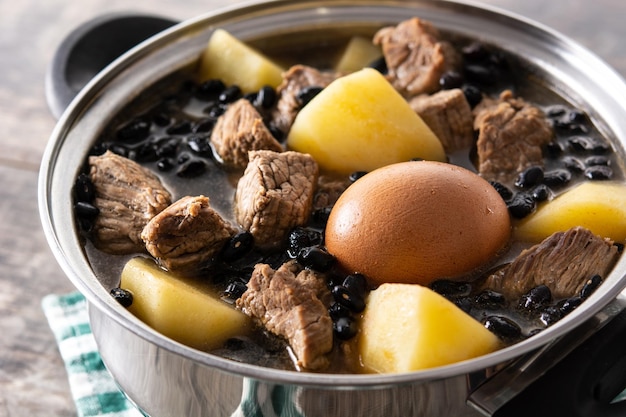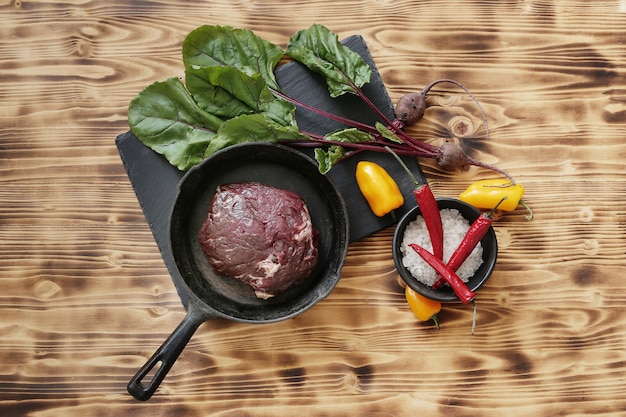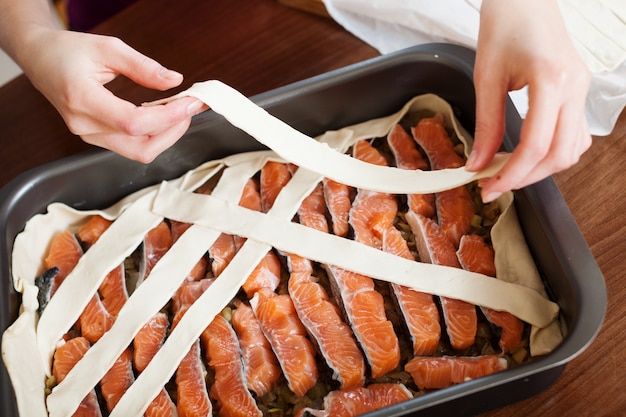You've got a hankering for brisket, eh? I'm right there with you! It's one of those dishes that seems intimidating, but trust me, it's not as hard as it looks. And the payoff? Oh, the payoff! A perfectly cooked brisket, falling apart tender and bursting with flavor, is pure culinary magic. It's the kind of dish that makes you feel like you've got cooking down to an art form, even if you're just starting out.
Don't get me wrong, there's a bit of prepping involved. But once you've got that sorted, the slow cooker does all the heavy lifting. And the aroma that wafts through your kitchen? Pure bliss!
So, are you ready for this culinary adventure? Grab a nice piece of brisket, follow my recipe, and get ready to impress. This dish will have your friends and family singing your praises. Let's get cooking!
(Part 1) Choosing the Right Brisket

First things first, the star of the show: the brisket. You need to find a good quality cut, and there are a few things you need to keep in mind.
Understanding the Cuts
There are two main types of brisket: the point and the flat. The point is the fatty end, packed with flavor. The flat is leaner, with a more even texture. If you're a beginner, I recommend starting with the flat – it's easier to cook and less likely to dry out. But hey, if you're feeling adventurous, go for the point! You can always trim off some of the fat if you're worried about it being too rich.
You'll also often see "packer brisket" – basically, the point and flat joined together. This is a good option for a crowd, but maybe a bit much for a first-timer.
Looking for the Right Brisket
Now, when you're picking your brisket, pay attention to the marbling. You want to see those beautiful streaks of fat running through the lean meat. This fat is going to melt during cooking, making the brisket incredibly juicy and flavorful. Also, make sure the brisket isn't dry or pale in color – you're looking for a healthy, vibrant hue.
(Part 2) Getting Ready for the Slow Cooker

Alright, you've got your brisket. Now it's time to get it ready for its slow-cooked adventure. This part is crucial – it sets the stage for a perfect result.
Trimming the Fat
First, you're going to trim off any excess fat. Now, don't go overboard and remove all of it – you want to leave a nice layer to keep the meat moist. But anything that's thick or uneven, give it a trim. I usually aim for about a quarter-inch layer of fat all over.
Seasoning the Brisket
Now comes the fun part: seasoning! This is where you get to experiment and find your own signature flavor. For a classic brisket, you can't go wrong with a simple salt and pepper rub. Generously season both sides of the brisket with coarse salt and freshly ground black pepper.
Don't be afraid to add other spices! Garlic powder, onion powder, paprika, cumin – they all add their own unique touch. Just remember to go easy on the spices, as you don't want to overwhelm the natural flavor of the brisket.
(Part 3) The Slow Cooker Magic

Okay, the moment of truth! You've prepped your brisket, it's seasoned up, and now it's time to unleash the magic of the slow cooker. This is where the real transformation happens, and it's surprisingly simple.
Setting the Stage for slow cooking
First, place the brisket in your slow cooker. You want it to fit snugly, but not be overcrowded. Here's a little trick I've learned: I like to put a few cups of beef broth or water in the bottom of the slow cooker before adding the brisket. This creates a moist environment, which helps prevent the brisket from drying out.
Choosing the Right Setting
Now, it's time to set the slow cooker. I usually cook my brisket on low for 8-10 hours, but you can also cook it on high for 4-6 hours. The key is to make sure the internal temperature reaches at least 190°F (88°C) – that's when the magic happens, and the brisket becomes incredibly tender and juicy.
(Part 4) The Wait is Over
The slow cooker is humming along, filling your kitchen with that irresistible aroma. Now all you have to do is wait. I know, I know, it's hard, but trust me, it's worth it. While you're waiting, you can prep your side dishes or even take a little nap!
The Importance of Patience
Remember, slow cooking is all about patience. Don't be tempted to lift the lid too often or peek at the brisket. Every time you open the slow cooker, you release heat and steam, which can affect the cooking time and moisture of the brisket. Just let it do its thing, and you'll be rewarded with a culinary masterpiece.
(Part 5) The Grand Finale: Shredding the Brisket
Okay, the slow cooker has done its work, and your brisket is ready for its moment in the spotlight! Take a peek, and if it's falling apart tender when you give it a gentle prod, you're good to go.
Testing the Tenderness
If you're not sure if it's ready, carefully use a meat thermometer to check the internal temperature. It should be at least 190°F (88°C). If it's not quite there yet, just pop it back in the slow cooker and let it cook a little longer.
Shredding to Perfection
Once the brisket is cooked to perfection, it's time to shred it. Use two forks or a pair of tongs to pull the meat apart. It should practically fall apart in your hands – that's exactly what you want!
(Part 6) The Delicious Possibilities
You've done it! You've cooked a magnificent brisket, and now it's time to enjoy the fruits of your labor. There are so many delicious possibilities, and I can assure you, none of them will disappoint.
Classic Sandwiches
First and foremost, you've got to try a classic brisket sandwich! Pile high some shredded brisket on a toasted bun, add some of the delicious juices from the slow cooker, maybe a bit of horseradish or barbecue sauce, and you've got yourself a culinary masterpiece.
Hearty Bowls
For a more substantial meal, try a brisket bowl. Pile some shredded brisket over a bed of rice or quinoa, add some roasted vegetables, a dollop of Greek yoghurt, and you've got a complete and satisfying dish.
Creative Dishes
And of course, you can get creative! Use the shredded brisket to make tacos, enchiladas, or even pasta dishes. The possibilities are endless, and the deliciousness is guaranteed!
(Part 7) Saving Leftovers
You've got a big pot of delicious brisket, and you know what that means? Leftovers! Don't worry, this is a good thing. You can easily store your brisket leftovers in the fridge for up to 3-4 days. Just transfer them to an airtight container, and they'll be just as good the next day.
Reheating Leftovers
When you're ready to enjoy those leftovers, you can reheat them in the microwave, oven, or stovetop. I personally prefer the oven method, as it keeps the brisket moist and tender. Just place it in a baking dish with a little bit of broth or water, cover it with foil, and bake it in a preheated oven at 350°F (175°C) until warmed through.
(Part 8) FAQs
So, you've tackled your first brisket, and you're feeling pretty good about yourself. But maybe you still have a few questions. No worries, I've got you covered!
| Question | Answer |
|---|---|
| Can I freeze leftover brisket? | Absolutely! You can freeze leftover brisket for up to 3 months. Just transfer it to a freezer-safe container or bag, and be sure to squeeze out as much air as possible before sealing it. When you're ready to use it, thaw it overnight in the refrigerator or in a bowl of cold water. |
| What kind of barbecue sauce should I use? | That's entirely up to your personal preference! There are so many different types of barbecue sauce out there, from sweet and smoky to tangy and spicy. I love a good Kansas City-style sauce, but feel free to experiment and find what you like best. |
| What are some good side dishes for brisket? | Brisket goes great with so many side dishes! Some classics include mashed potatoes, baked beans, coleslaw, mac and cheese, and cornbread. You can also get more creative with roasted vegetables, salads, or even a side of creamy risotto. |
| What if my brisket is too dry? | It's not uncommon for brisket to dry out a little bit during cooking. To combat this, you can try adding a bit more broth or water to the slow cooker during cooking. You can also baste the brisket with sauce or broth throughout the cooking process. |
| What if my brisket is still tough after cooking for a long time? | If your brisket is still tough after cooking for a long time, it might be a sign that you didn't trim the fat properly or that the brisket wasn't cooked long enough. You can try braising it in a dutch oven for an additional 30-60 minutes. Just add some broth or water to the Dutch oven, bring it to a simmer, and cook the brisket until it's tender. |
There you have it! You've learned the secrets of slow-cooking brisket, and you're ready to wow your friends and family with a mouth-watering meal. Remember, the key is to choose a good cut of meat, trim the fat, season it well, and let the slow cooker do its magic. And don't be afraid to experiment with your seasonings and side dishes! Happy cooking!
Adding more depth and specific details1. More detail on choosing the brisket: Explain the difference between "select" and "choice" grades of beef for brisket. Provide a visual guide for identifying good marbling. Discuss the benefits of using a butcher to get a perfect cut.2. Explain the importance of resting the brisket: Add a section after shredding the brisket explaining why resting it for 30 minutes or more is important for moisture and tenderness.3. Expand on side dish options: Provide recipes for a few simple and delicious side dishes that pair well with brisket. 4. Incorporate anecdotes and personal stories: Share your own experiences with brisket, any mistakes you made, and how you learned from them. Tell a story about a memorable time you served brisket.5. Add visual elements: Include pictures or illustrations throughout the article to make it more engaging. Create a visually appealing table for the FAQs section.6. Use more engaging language: Instead of simply stating facts, use descriptive language to evoke the senses. Incorporate contractions and colloquialisms to make the writing sound more natural and conversational.By incorporating these suggestions, you can create a more engaging and informative article that will inspire readers to try their hand at slow-cooking brisket.Everyone is watching

Corn on the Cob: The Ultimate Guide to Perfectly Cooked Ears
Healthy MealsAh, corn on the cob. Just the name evokes images of sunny days, barbecues, and that sweet, juicy flavour that ...

Perfect Pork Roast Oven Cooking Time: A Guide to Delicious Results
Healthy MealsThere's something truly satisfying about a perfectly roasted pork. The aroma alone is enough to make your mout...

Ham Cooking Time: How Long to Bake, Smoke, or Boil a Delicious Ham
Healthy MealsAh, ham. It's a classic, isn't it? A real crowd-pleaser, especially around holidays. And when done right, it'...

Scallops: The Ultimate Guide to Perfect Cooking
Healthy MealsAh, scallops. Those delicate, sweet, and utterly delicious morsels of the sea. They hold a special place in my...

Spaghetti Squash: The Ultimate Guide to Cooking and Serving
Healthy MealsRemember that time you saw spaghetti squash at the supermarket, looking all bumpy and strange, and thought, "W...
